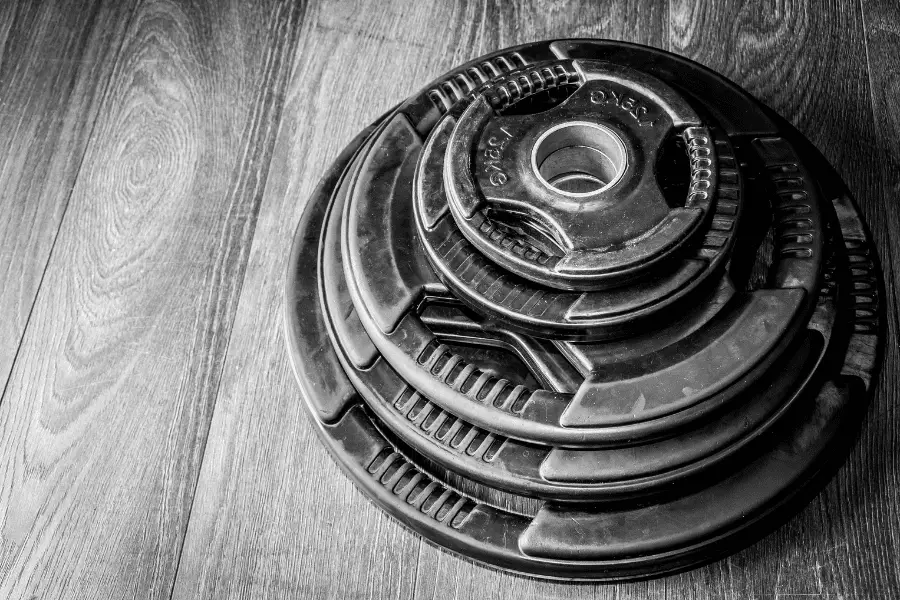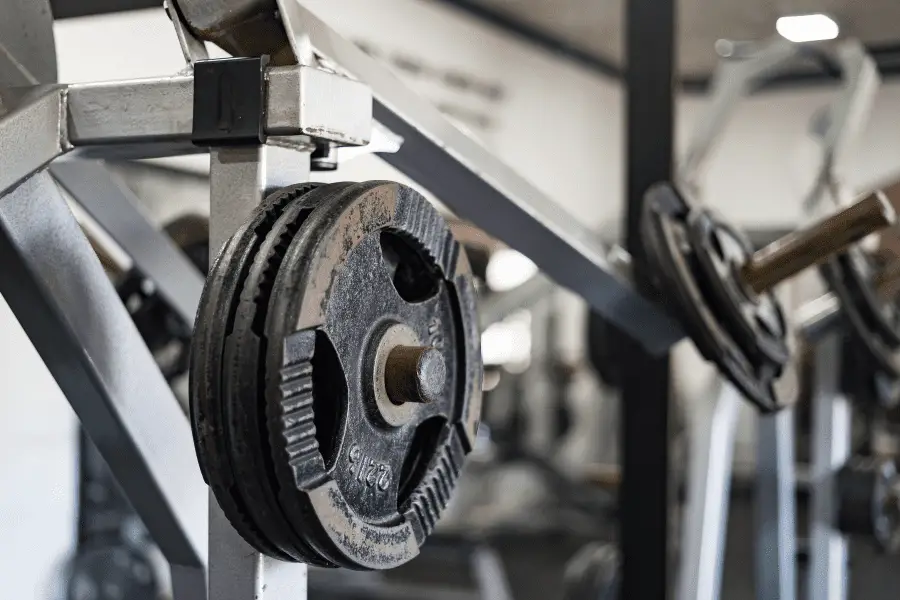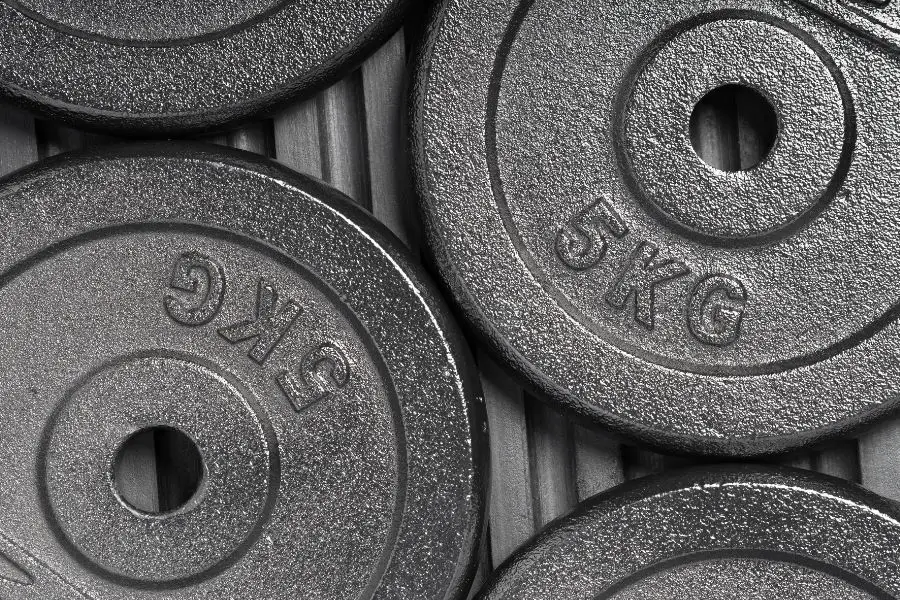Setting up your home or garage gym is an exciting journey, and choosing the right weight plates is a pivotal part of the process. Picking the wrong type can mean they don’t fit, are uncomfortable to use or don’t last long while picking the right ones means they can last for decades.
In this guide, we’ll break down the essential factors to consider, ensuring your workouts are not only effective but safe as well.
Contents
- 1 1. Do You Need Weight Plates?
- 2 2. Bumper vs. Steel Plates
- 3 3. Match Your Weight Plates To Your Barbell
- 4 Tip
- 5 4. Coated vs. Bare Weight Plates
- 6 5. Features to Look For
- 7 6. What’s Your Budget?
- 8 7. Get a Well-Structured Set
- 9 8. Kilo vs. Pound Plates
- 10 Do You Need Color-Coded Plates?
- 11 Plates to Avoid
- 12 What About Specialty Plates?
Key Takeaways
If you want to drop the barbell repeatedly like you do with Olympic lifts and Crossfit, use bumper plates. For other purposes like general fitness and bodybuilding, cast iron plates with grip holes are a better choice. Bare cast iron grip plates are a great, durable budget option. Rubber or urethane coated plates are more expensive but quieter and more comfortable to use.
Don’t want to figure out which weight plates are great for your home gym? Here is an article that quickly recommends the best for your situation.
1. Do You Need Weight Plates?
“First things first – do you really need those weight plates for your home or garage gym? Well, before we get into all the nitty-gritty details, let’s break it down.
Weight plates team up with barbells and plate-loaded machines. They slide on the sleeves of barbells or the pegs of machines to add resistance.
Yes, there are some exercises you could do with weight plates that don’t require a bar or machine but in most of those cases, you’re better off with a set of dumbbells or kettlebells. If you want to barbell squat, deadlift, bench, etc., You need a barbell and plates.
2. Bumper vs. Steel Plates
When it comes to picking weight plates, one of the biggest decisions you’ll face is whether to go for bumper plates or steel plates. Each type has its own unique perks and specific uses.
Here’s what it comes down to:
| Type of Plate | Bumper | Cast Iron/Coated | |
| Used For | Olympic-style lifts, Crossfit | General Fitness, Bodybuilding | |
| Drop | Are built to be dropped repeatedly | Shouldn’t be dropped | |
| Diameter | 450 mm for all weights | Different weights have different diameters | |
| Thickness | 45-pound plates are 2.5-3.2″ thick. | 45-pound plates are +-1.5″ thick. | |
| Longevity | 3-4 years for a low quality set, 10+ years for high quality | Many decades if not dropped | |
Pick the type of plates that matches your needs the closest. As said, the key factor here is if you drop your barbell. If you do; bumpers, if you don’t; cast iron.
3. Match Your Weight Plates To Your Barbell
Here’s a crucial tip: You’ve got to make sure your weight plates and barbell actually fit together. There are standard and Olympic plates. And the same is true for barbells.
For people that need bumper plates: Those are always Olympic (50mm) style so you don’t have to think about this.
Tip
Some people already have a standard 1″ barbell or other equipment. In that case, it’s understandable you want a standard plate set. However, a decent Olympic barbell can be had for about $150. While that’s not nothing, compared to a set of plates, it’s not all that much so upgrading might be worth it.
There are adapter sleeves for 1″ barbells that allow them to take 2″ Olympic plates. This is a solution if you’re lacking the funds for a new barbell at the moment. Be aware that those adapters don’t remove all the drawbacks of using a standard bar.
4. Coated vs. Bare Weight Plates
If you’ve decided to skip the bumper plates You need to choose between bare steel or coated weight plates.
| Coated vs. Bare Iron | Rubber/Urethane Coated | Bare Cast Iron | |
| Core | Cast Iron | Cast Iron | |
| Coating | Rubber or Urethane | Paint | |
| Noise | Relatively quiet | Noisy | |
| Floor protection | Coating provides some impact protection | None | |
| Comfort | More comfortable to handle | Less comfortable to handle | |
| Aesthetics | Modern | Classic | |
| Price | More expensive | Cheaper |
Coated Plates

Coated or encased plates are cast iron on the inside just like bare steel plates. They come with coatings like rubber or urethane that pack some nifty benefits.
- Protection: First, they’ve got your floor’s back. You’ll get fewer scratches or dents. The coating also provides some impact damping for the plates, reducing the chance of breaking or chipping. That doesn’t mean these can be dropped like bumper plates though.
- Noise: They’re also the quiet type. Two rubber objects banging against each other is a lot quieter than two steel objects.
- Comfortable: These are also more comfortable to handle although some people prefer the feel of raw iron in their hands.
So, if you’re all about a peaceful workout environment and floor protection, coated plates are your buddies. However, they do cost more than bare steel plates. Urethane coated plates are more expensive than rubber ones but they look nicer for much longer.
Bare Steel Plates

These are the OGs, the classics of the weight plate world. They might be a bit noisier when they hit the ground, and they don’t know much about floor protection, but here’s why people still love ’em:
- Budget-Friendly: They’re often lighter on the wallet. So, if you’re watching your pennies, these plates won’t break the bank.
- Traditional Vibes: They bring that old-school gym feeling. Clanks and all, they’re like a throwback to the good ol’ days of lifting.
In the end, this is a budget question for most people. Do you spend more for a coating and get some benefits or do you keep your wallet happy? If you can afford it, coated plates are better.
5. Features to Look For
When you’re on the hunt for the perfect weight plates for your home or garage gym, don’t overlook these extra features. They are optional but can be the decider over one set vs. the other. The choices you’ve made above are more important than these features though.
Grip Holes
Have you seen the phrase “grip plates” when shopping for weights? All that means is that the plates have holes in them that make the plate easier to load/unload and handle. They are a great addition to a weight plate and something you should look for.
Grip plates are easier to handle because of the holes. Always try to buy cast iron or coated plates with grip holes.
Bumper plates don’t have grip holes but bare steel and coated plates do. They do make a difference in the day-to-day feel of a plate and how easy it is to use. Plates without grip holes can be a pain sometimes. So, if you’re all about convenience, keep an eye out for plates with grip holes.
Stainless Steel Inserts

These inserts sit around the rim of the inner hole of a weight plate. Some plates have them, some don’t (they’re practically always stainless if a plate has them).
These inserts protect the rest of the plate from wear and tear. This can happen from sliding the bar on and off the barbell sleeve. These inserts also make loading and unloading a bit easier. I’ve noticed that plates without inserts tend to ‘stick’ on a sleeve more.
Steel inserts are generally also machined more precisely which means they fit tighter and more securely around the barbell sleeve.
It’s not a dealbreaker if a cast iron set doesn’t have inserts on iron plates. On bumper plates, these are absolutely necessary since the rubber core of these plates is more vulnerable.
Beveled Edges
Beveled edges are a widely overlooked feature of weight plates, especially bumper plates. Instead of sharp corners, they’ve got a 45-degree edge between the top and side of the plate. Here’s why you might want them:
- Safety First: Those beveled edges reduce the risk of accidents. No more worries about sharp corners bumping into you or your floor during workouts.
- Pick Up From The Floor: When a plate lies flat on the floor, and the edges are straight, it can be a real struggle to pick it up. With a beveled edge, you can easily get your fingers under there.
- Unloading the Bar: This edge gives you something to grab onto when separating plates on the bar.
Plates with grip holes don’t need these edges but on bumper plates, this is very nice to have.
6. What’s Your Budget?
Let’s talk about the money side of things because, let’s face it, our budget often calls the shots. Here’s what you need to know:
eight plates come in all flavors, from basic to premium. Think of them like your car options – you can go for the budget model or splurge on the luxury ride.
Investing a bit more in high-quality plates can be a smart move. They tend to be super durable and spot-on with their weight measurements. So, you’re not just buying weight plates; you’re investing in a long-lasting gym buddy.
Bottom line? Get the best plates you can afford while taking the points above into account, and they’ll pay you back in longevity and accuracy. They look and feel nicer too.
7. Get a Well-Structured Set
The key to building strength and muscle is lifting a bit more weight over time. In other words; progressive overload.
To do this properly, you need a set that allows you to increase the weight on the bar in 5-pound/2.5 kg steps. You don’t want to have to increase the weight too much because you likely won’t be able to lift it which defeats the point.
You need the right amount of weight plates of each different weight to do this. Here is the basic set you need;
| Weight (lbs.) | Number Needed | Total Weight (lbs.) |
|---|---|---|
| 45 | 2 | 90 |
| 25 | 2 | 50 |
| 10 | 4 | 40 |
| 5 | 2 | 10 |
| 2.5 | 2 | 5 |
| 195 Lbs. |
Here is an in-depth post on how many plates you need of each weight.
8. Kilo vs. Pound Plates
Some weight plates are denominated in kilos while others are in pounds. While there are some tiny differences in regards to load increases, for most people these don’t matter.
Just get the plates that have a unit of measurement on them that you’re the most familiar with. Since that mainly depends on where you from, it’s likely that that type of plates is the most common where you live anyways.
Do You Need Color-Coded Plates?
Some bumper plates are color coded. That means every different weight has a different color. This makes it easy to see how much weight you’ve got on the bar and if the bar is loaded evenly on both sides.

However, in most home gyms, this isn’t a necessary feature. It’s more for competitive environments where plates have to be changed very quickly and it’s easy to make mistakes.
Of course if you like the touch of color and convenience, get a set of color coded bumpers. However, there is less choice and they usually cost a bit more.
Cast iron and rubber-encased plates are not color coded. That’s because with those plates, the different types have different diameters which makes it much easier to identify them.
Color-coded plates weights
The color coding of weight plates can vary depending on the manufacturer and the specific brand of plates. However, there are some common color associations for standard Olympic weight plates:
Plates to Avoid
While there are many good weight plates and some that are fine for home gyms or for certain purposes, there are also some weight plates that you should absolutely avoid
Here are two types I recommend avoiding:
1. Sand/Cement-Filled Plates

Sand or cement-filled weight plates are not a good choice for several reasons:
- Durability: These plates are generally less durable compared to other types. The sand or cement filling can deteriorate over time, potentially leading to plate breakage and a mess in your gym. These can also not handle any impact since the plastic shells break easily.
- Weight Accuracy: Sand/cement-filled plates are known for their weight variability. They may not actually weigh the amount that’s printed on them, making it challenging to track your progress effectively.
For any serious fitness, bodybuilding or weightlifting, these plates are not what you want. Getting the cheapest set of cast iron plates is going to be a lot better.
2. Standard Plates

Standard weight plates have a 1-inch diameter hole as opposed to the 2-inch hole of Olympic plates. While they may be suitable for some situations, they come with limitations:
- Compatibility: Standard plates only fit on equipment and barbells with 1-inch sleeves. This can limit your options for using different barbells or equipment in the future.
- Quality: Standard plates are generally of lower quality compared to Olympic plates. This may result in weight inaccuracies, which can be problematic if you are focused on precise training.
- Bumpers Not Available: If you need bumper plates for Olympic lifting or high-impact exercises, you won’t find them with the standard 1-inch hole size.
For most home and garage gym setups, Olympic plates tend to be the preferred choice due to their compatibility with a wide range of equipment and barbells, as well as their higher quality and accuracy. However, if you have specific reasons for using standard plates, such as compatibility with existing equipment, be sure to consider your needs carefully.
What About Specialty Plates?
There are some types of weight plates you might come across when shopping for plates. In most cases, there’s no need for these plates in a home or garage gym.
Here is an article that explains all the types of weight plates and their uses.
Calibrated Plates:
- Purpose: Calibrated weight plates are precision-engineered for competitive powerlifting. They weigh exactly the amount the label claims. Non-calibrated plates can differ quite a bit.
- Do You Need Them: If you’re a competitive powerlifter or participate in official powerlifting competitions, calibrated plates are great for training since it’ll be exactly what you have to lift during competitions. However, for most home gym users, these plates are overkill.
Competition Plates:
- Purpose: Competition weight plates are designed to meet strict international standards for powerlifting and weightlifting competitions. Unlike calibrated plates, these are certified to be used in competitions.
- Do You Need Them: If you run an official weightlifting competition, yes, otherwise you don’t.
Deep Dish Plates:
- Purpose: Deep dish weight plates have a wider rim around the edges, which can provide extra durability and floor protection. They are also known for their classic appearance.
- Do You Need Them: Deep dish plates are suitable for those who prioritize floor protection and appreciate the classic design. However, they may not be necessary for most gym setups.
